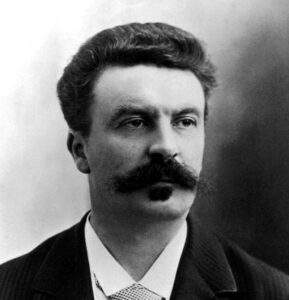Maupassant A Piece of String | An Analytical Study
Maupassant A Piece of String | An Analytical Studydy
Maupassant A Piece of String | An Analytical Study
A Piece of String’ is a French short story by Guy de Maupassant (1850-1893), a reputed French storyteller. It is a tragic as well as a pathetic short story. The main theme of the story is enmity and envy. In this short story, the author has shown how an innocent man named Hauchecome became the victim of enmity and jealousy and how he happened to suffer mentally- which became the sole cause of his pathetic death. Besides this, the author has brought about a vivid social picture of the second half of nineteenth-century France.
It is especially a story of a poor peasant called Hauchecome. One day he went to the market of Goderville. When the market was in full swing he, being just arrived at the market, happened to notice a piece of string lying on the ground. Hauchecome, economical like a true Norman, thought that everything useful ought to be picked up and hence took up the piece of string from the ground and put it in his trouser’s pocket. The act of picking up the piece of string was seen by a man named Malandine. He was a harness-maker and both Hauchecome and Malandain had once quarreled over the matter of a halter and hence they were on bad terms and since then they became good haters. After picking up the piece of string, Hauchecome went to a tavern called Jourdain’s tavern and began to take refreshments. In the meantime, a public crier came in front of the tavern and announced:
“It is hereby made known to the inhabitant of Goderville and in general to all the persons present at the market, that there was lost this morning, on the road to Benzeville, between nine and ten o’clock, a black leather pocketbook containing five hundred francs and some business papers. The finder is requested to return with all the haste to the mayor’s office or to Monsieur Fortune Houlbreque of Mannerville. There will be a reward of twenty francs.”
A little later, a police officer appeared at the door and called Hauchecome to the mayor’s office. Hauchecome, being astonished and puzzled, went to the mayor’s office and found that the mayor was awaiting him. Then the mayor brought a charge against him that he was seen by Malandain, the harness-maker, to pick up the pocketbook this morning. Hauchecome was shocked and protested. He was confronted with Malandain. Hauchecome was searched but nothing was found on him. Finally, the mayor, being perplexed, discharged him with the warning that he would consult the public prosecutor and ask for further order. Hauchecome left the mayor’s office and he was surrounded by people and questioned him with a serious bantering curiosity. He began to tell the story of the string. Night fell on and he was returning home and on the street whomever he met he recounted the story of the piece of string. The thought of it made him ill at night. The next day about one o’clock a man named Marius Paumelle, a hired man in the employ of Mr. Breton of Manville returned the pocketbook. Hauchecome was calm now but yet something disturbed him and began to tell the story of the string to the people to refute the false accusation brought against him. But nobody seemed to believe him. And when he began to tell his story a horse dealer of Monvillers mocked at him saying, “Shut up, papa. There is one that finds and there is one that reports. At any rate, you are mixed with it.” This comment made Hauchecome more suffered. Thus the more he told his story in his self-defense the more he faced disbelief. Towards the end of December, he took to his bed. He died in the first days of January and in the delirium of his death struggle he kept claiming his innocence, reiterating, “A Piece of string, a piece of string—look— here it is, M’sieu the Mayor.”
Thus the author has portrayed the mental sufferance of an innocent man who was falsely charged with finding a pocketbook.
There are three characters—Hauchecome, Malandain, and the Mayor but Mr. Hauchecome is the principal character of the story. He is a poor peasant suffering from rheumatism. He was as economical as a true Norman and hence he picked up a piece of string from the ground which became the cause of his sufferance. His enemy, Malandain took the chance of it and brought a charge against him of finding the pocketbook lost by Mr. Fortune Houlbreque of Mannerville. He tried his best to prove his innocence but nobody seemed to believe him and then he began to suffer from acute mental agony that later on became the sole cause of his death. He is the most realistic pathetic character if compared with the other characters ever produced by Guy de Maupassant in his short stories. The second important character of the story is Malandain. He is quarrelsome and jealous of his enemy. For him, Hauchecome had to suffer a lot in life. The third character in the story is the Mayor. He was the notary of the vicinity. He was a stout and serious man with a pompous voice.
In narrating the story the author has employed the Objective Method with skill. In this method, an author keeps himself away from his story and delineates his story objectively.
The story, in Structure, is a perfect one. It bears visibly all the stages of a good short story. The opening is direct. In the opening, the storyteller gives a brief but vivid picture of the forlorn and pathetic condition of the France people, especially of the peasants. The main story begins as soon as the main character Hauchecome appears in the scene. It meets its climax, through logical complication, after the missing pocketbook was found and returned by Mr. Breton of Ymanville and Hauchecome still began to face disbelief from his hearers. The denouement meets with the death of Hauchecome.
The Setting of the story is consistent with the events and situation. But the author is very economic but exact in portraying the setting of his event. The vivid account of the condition of the peasant in the exposition of the story is as:
”All along the road of Goderville, the peasants and their wives were coming towards the town because it was market day. The men were proceeding with slow steps. The whole body bent forward at each movement of their long twisted legs, deformed by their hard work, by the weight on the plough, which at the same time raised their left shoulders and swerved the figure, by the reaping of the wheat which made the knees spread in order to hold the wheat firmly, by the slow and painful labour of the country. Their blue blouses ornamented with a little design in white at the neck and the wrists, puffed about their bony bodies, seemed like balloons ready to carry them off. From each of them a head, two arms and two legs protruded.”
The Dialogues employed in the story are very logical as he uses them sparingly but all the dialogues have taken a decisive role in goading his story ahead and in unfolding the inner motives of his characters.
The Philosophy of Life is also found in the story. The author has not expressed it directly but leaves it to be drawn out by his readers after the reading it. The story suggests that jealousy of an enemy is always dangerous.
The Language of the story is not a simple one but full of complexity as the second sentence of the story bears as many as eight clauses which are not easy for the average reader to interpret precisely. But this complexity suits the entire theme of the story as it is a short story which is enough to give us a vivid and reliable pen picture of the pathetic social condition of the peasants of the second half of nineteenth-century France.
All the qualities of a good short story as —unity of purpose, brevity, spontaneity and universality are present in this short story. The brevity which is thought of as the soul of a short story is also maintained throughout the story as all the component elements of a good short story are employed in the story with possible economy without causing any harm to the perfectness of the story. Thus Universality is gained by means of the reliable representation of the theme and event. The story begins and ends with a spontaneous logical order and the author seems not to use any force in bringing about the denouement of his story through proper stages.
As a short story, its Length is ideal as —neither very short nor long.
The analysis of the story as done above shows that all the elements and qualities of a good short story are present in it so it may be called that it is a short story of the first grade. 0 0 0
Maupassant A Piece of String | An Analytical Study
Read More: Guy de Maupassant’s Short Stroy ‘The Jewel’-An Analytical Study
N. B. This article entitled ‘Maupassant A Piece of String | An Analytical Study’ originally belongs to the book ‘World Short Story Criticism‘ by Menonim Menonimus. Maupassant A Piece of String | An Analytical Study
Books of Literary Criticism by M. Menonimus:
- World Short Story Criticism
- World Poetry Criticism
- World Drama Criticism
- World Novel Criticism
- World Essay Criticism
- Indian English Poetry Criticism
- Indian English Poets and Poetry Chief Features
- Emily Dickinson’s Poetry-A Thematic Study
- Walt Whitman’s Poetry-A Thematic Study
- Critical Essays on English Poetry
- Tawfiq al-Hakim’s Novel: Return of the Spirit-An Analytical Study
- Tawfiq al-Hakim’s Novel: ‘Yawmiyyat Naib Fil Arayaf’-An Analytical Study
- Analytical Studies of Some Arabic Short Stories
- A Brief History of Arabic Literature: Pre-Islamic Period …
Books on Linguistics by M. Menonimus:
- A Brief History of the English Language
- Essays on Linguistics
- My Imageries
- Felicitous Expression: Some Examples
- Learners’ English Dictionary
Related Searches:
- Short Stroy Criticism
- The Indian English Short Story
- Individual and Society …
- ‘Deliverance’ by Premchand Analysis
- Summary of Rabindranath Tagore’s ‘The Exercise Book
- Short Story ‘Yellow Fish’ Essay Example
- Notes on Roger Mais’s ‘Blackout’
- ‘Blackout’ by Roger Mais
- ‘The Dog of Tetwal’ Saadat Hasan Manto
- The Dog of Tethwal
- ‘The Jewelry’ by Guy De Maupassant Analysis
- ‘The Jewels’ by Guy De Maupassant
- ‘The Necklace’ Essay
- Study Question ‘The Necklace’
- The Piece of String’ Analysis
- The Piece of String’…











